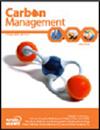Fluorinated greenhouse gas and net-zero emissions from the electronics industry: the proof is in the pudding
IF 3.2
4区 环境科学与生态学
Q3 ENVIRONMENTAL SCIENCES
引用次数: 0
Abstract
Abstract The electronics industry has made remarkable progress over the past 25 years in reducing the emission intensity of long-lived volatile fluorinated compounds (FCs) that typically represent 80 to 90% of uncontrolled direct (scope 1) greenhouse gas (GHG) emissions during the manufacturing of semiconductor, display, and photovoltaic devices. However, while Normalized Emission Rates (NERs) have decreased in terms of CO2-equivalent emissions per surface area of electronic devices produced, absolute FC emissions from the sector have continued to grow at a compound annual rate of 3.4% between 1995 and 2020. Despite these trends, industry has not, to date, renewed their sectoral commitments to strengthen global FC emission reduction goals for the 2020–2030 decade, and it is unlikely that recently announced net-zero emission objectives from a few leading companies can reverse upwards industry emission trends in the near-term. Meanwhile, the persisting gap between “top-down” atmospheric measurements-based FC emission estimates and “bottom-up” emissions estimates is increasingly concerning as recent studies suggest that the gap is likely due, in part, to an underestimation of FC emissions from the electronics sector. Thus, the accuracy of industry-average (Tier 2) emission factors is increasingly questionable. Considering that most FCs essentially permanently persist in the atmosphere on a human time scale, the electronics industry needs to reassert its collective leadership on climate action, increase its ambition to reduce absolute emissions, and ground net-zero commitments in science by embarking on a concerted effort to monitor, report, and verify their process and abatement emission factors. To this effect, this article provides practicable solutions to cross-check bottom-up and top-down emission factors at the facility level and suggests that further implementing cost-effective FC abatement technologies, possibly in conjunction with a sectoral cap-and-trade mechanism, can help achieve residual FC emission levels compatible with net-zero neutralization principles and the 1.5 °C objective of the Paris Agreement.电子工业的氟化温室气体和净零排放:布丁就是证据
本文章由计算机程序翻译,如有差异,请以英文原文为准。
求助全文
约1分钟内获得全文
求助全文
来源期刊

Carbon Management
ENVIRONMENTAL SCIENCES-
CiteScore
5.80
自引率
3.20%
发文量
35
期刊介绍:
Carbon Management is a scholarly peer-reviewed forum for insights from the diverse array of disciplines that enhance our understanding of carbon dioxide and other GHG interactions – from biology, ecology, chemistry and engineering to law, policy, economics and sociology.
The core aim of Carbon Management is it to examine the options and mechanisms for mitigating the causes and impacts of climate change, which includes mechanisms for reducing emissions and enhancing the removal of GHGs from the atmosphere, as well as metrics used to measure performance of options and mechanisms resulting from international treaties, domestic policies, local regulations, environmental markets, technologies, industrial efforts and consumer choices.
One key aim of the journal is to catalyse intellectual debate in an inclusive and scientific manner on the practical work of policy implementation related to the long-term effort of managing our global GHG emissions and impacts. Decisions made in the near future will have profound impacts on the global climate and biosphere. Carbon Management delivers research findings in an accessible format to inform decisions in the fields of research, education, management and environmental policy.
 求助内容:
求助内容: 应助结果提醒方式:
应助结果提醒方式:


